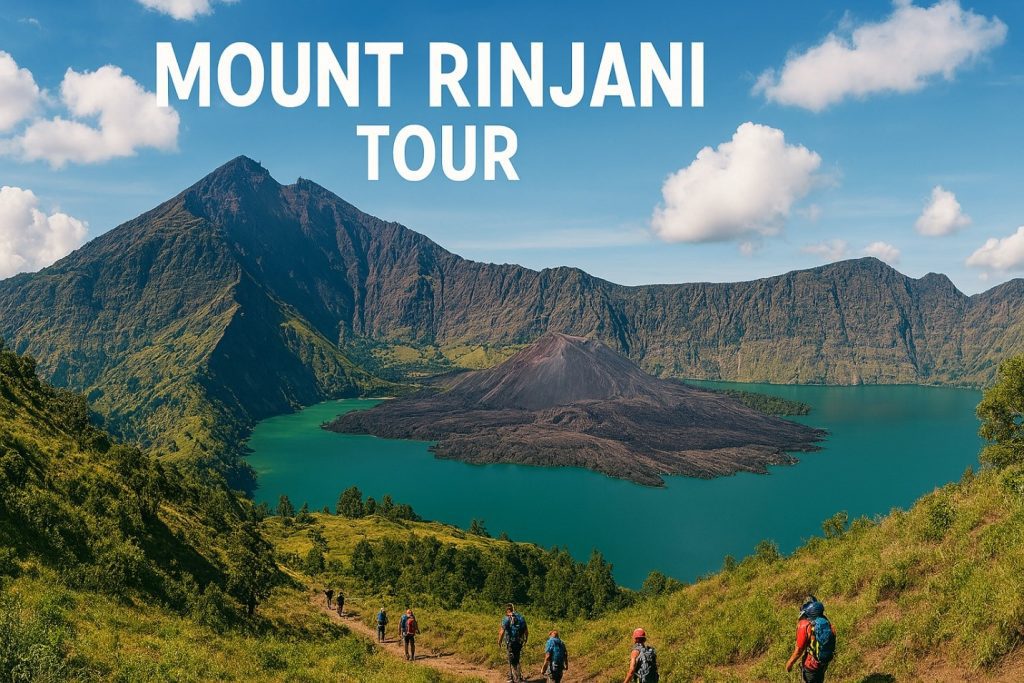Mount Rinjani, an active volcano on the island of Lombok, Indonesia, offers one of Southeast Asia’s most spectacular and challenging treks. Reaching 3,726 meters (12,224 feet), it’s the second-highest volcano in Indonesia and is a protected area within Mount Rinjani National Park (Taman Nasional Gunung Rinjani). A trek to its summit and the stunning crater lake, Segara Anak, is a truly unforgettable experience.
The Mountain and Its Significance
Mount Rinjani is a majestic stratovolcano, dominating the landscape of Lombok. It holds deep spiritual significance for the local Sasak people and Balinese Hindus, who often perform annual rituals on the slopes and at the lake.
- Segara Anak: The breathtaking turquoise crater lake, meaning “Child of the Sea,” sits at an altitude of 2,000 meters (6,560 feet). In the lake, a smaller, new cone, Mount Barujari, is continuously forming, showing Rinjani’s ongoing volcanic activity.
Essential Mount Rinjani Tour and Trekking Information
Mount Rinjani Trekking requires preparation and a good level of fitness. Treks typically range from two to four days, depending on the route and destination. All trekkers must use the services of a licensed guide and porters for safety and environmental protection.
Popular Trekking Routes
There are two main official starting points for the trek:
- Sembalun Route (East Lombok):
- This is the most common route to the summit (3,726m).
- It starts at a higher altitude, making the initial ascent less steep, but it has a very challenging, long, and sandy final push to the peak.
- Ideal for those aiming to reach the absolute summit.
- Senaru Route (North Lombok):
- This route is more challenging initially, involving a steep ascent through dense tropical forest.
- It leads to the Senaru Crater Rim (2,641m), which offers incredible views of the lake and the summit, but does not usually include the final summit climb.
- Perfect for a shorter, less strenuous trek focusing on the crater rim view.
Typical Trekking Itineraries
3-Day/2-Night Summit Trek (Sembalun-Sembalun or Sembalun-Senaru)
This is the classic itinerary designed for reaching the main summit:
- Day 1: Trek from Sembalun to Sembalun Crater Rim (Plawangan Sembalun). A long day of hiking, followed by camping on the rim.
- Day 2: Early morning ascent to the summit for sunrise. Return to the crater rim, descend to the Segara Anak lake for a swim and visit to hot springs, then ascend to the Senaru Crater Rim (Plawangan Senaru) for the second night’s camp.
- Day 3: Descend through the forest back to the village of Senaru.
2-Day/1-Night Senaru Crater Rim Trek (Senaru-Senaru)
This is a good option for those with less time or moderate fitness:
- Day 1: Trek from Senaru village through the forest to the Senaru Crater Rim. Camp overnight.
- Day 2: Enjoy the sunrise view before descending back down the same route to Senaru.
Preparation and Gear
Proper preparation is vital for a safe and enjoyable trek. The conditions on the mountain can vary drastically, from hot and humid forest to freezing cold and windy on the rim and summit.
- Fitness: A moderate to high level of fitness is necessary. The trek involves long days of walking, steep inclines, and high altitudes.
- Essentials: Bring warm layers (gloves, hat, thermal shirt), a windproof and waterproof jacket, sturdy hiking boots, sunscreen, and a headlamp.
- Support Team: Your guides and porters are essential. They carry all the necessary camping equipment, food, and water. They are your lifeline and their expertise is invaluable for safety and navigation. Tipping them at the end of the trek is customary.
Environmental Responsibility
Mount Rinjani Tour is a fragile ecosystem. Trekkers are strongly urged to practice “Leave No Trace” principles. This means packing out all trash, staying on marked trails, and respecting the wildlife. By choosing an official tour operator, you contribute to the local economy and conservation efforts. Check the official park closure dates, as the park is typically closed during the height of the rainy season (usually January to March) for safety and maintenance.
